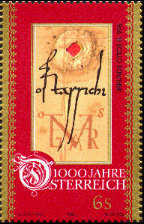
| Austria Cafe |

|
The Country and its
People
|
|||||||||||||||
|
Austria is located in southern Central Europe. Geographically, its territory encompasses both the Eastern Alps (which cover some two thirds of its surface area) and the Danube Region. Austria has a land surface of 83,858 square kilometres (32,369 square miles). Given its location, it has since time immemorial been a cross-roads of travel routes between the major European economic and cultural regions. Austria has common borders with eight other countries: Germany, the Czech Republic, Slovakia, Hungary, Slovenia, Italy, Switzerland and Liechtenstein. |
||||||||||||||||
|
This European heartland combines a wide variety of landscapes, climatic conditions and flora. Austria's landscapes range from the peaks of the Alps to hill country and plains. The foothills of the Alps and the Carpathians, the Vienna Basin and the Austrian segment of the Pannonian Plain in the East are the principal areas of settlement and economic activity. Austria's highest mountain is the Grossglockner (3,797 metres / 12,530 feet). Its longest river is the Danube, which flows through Austria for a length of some 350 kilometres (220 miles). |
||||||||||||||||
|
Austria is located within a temperate climatic zone. In the west and northwest the influence of the temperate Atlantic climate is felt more strongly, in the east the influence of the continental climate. Precipitation levels vary significantly along a west-east axis and rise with altitude. The diversity of topographical and climatic conditions accounts for the country's abundant flora and fauna. Austria is one of Europe's most heavily wooded countries (46% of its surface area). |
||||||||||||||||
|
Austria is a federal state consisting of nine independent federal states: Burgenland, Carinthia, Lower Austria, Salzburg, Styria, Tyrol, Upper Austria, Vienna and Vorarlberg.
|
||||||||||||||||
|
The Austrian population totals slightly more than eight million, some 98% of whom are German-speaking. The six ethnic groups officially recognised in Austria are concentrated on the east and south of the country. In 1997 the population was made up of 4.1 million female and 3.9 million male Austrians. The mean life expectancy for a new-born male stood at 73.9 years, for a new-born female at 80.2 years. |
||||||||||||||||
|
In terms of religious allegiances, 78% of Austrians are Roman Catholic, a further 5% Protestant (principally Augsburg Confession). Some 4.5% of the population belong to another faith, 9% belong to no religious group, and 3.5% did not respond. |